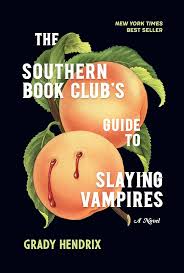Author’s Note
byAuthor’s Note — A few years ago, I wrote a novel titled My Best Friend’s Exorcism, set in 1988 Charleston during the height of the Satanic Panic. The story followed two teenage girls who become convinced that one of them is possessed, resulting in a dark spiral of chaos and fear. Because it was told through a teenager’s eyes, the adults were portrayed as clueless and out of touch—just as they often appear when you’re young and overwhelmed.
But that perspective is only half the story. From a parent’s point of view, the fear hits differently. There’s nothing more paralyzing than watching your child suffer and feeling completely powerless to help. It was this unsettling truth that inspired my next book, The Southern Book Club’s Guide to Slaying Vampires. Though it’s not a direct sequel, it shares a setting with my earlier work—an echo of the same Charleston neighborhood, only viewed through older, wiser eyes.
Growing up, I saw my mother and her friends as background characters—ladies in minivans who juggled chores, PTA meetings, and book club discussions. At the time, it all felt lightweight, like they were just passing time while waiting for life to happen. I didn’t realize how much weight they carried quietly: the unpaid emotional labor, the invisible pressures, and the daily effort to shield their children from a world that could turn brutal without warning. That realization hit hard when I got older—and it reshaped the way I write women, especially mothers.
This book explores the everyday heroism of mothers and housewives. These women operate in the margins, rarely recognized but constantly holding things together. They manage emotional crises, navigate social politics, and absorb so much so that their children can move through life feeling safe. The characters in this story are a tribute to the silent resilience of mothers who protect without ever being thanked for it.
Vampires play a symbolic role here, too. They’re more than just creatures of folklore; they’re metaphors for what preys on communities undetected. The American vampire has evolved into something deeply reflective of our fears—drifters without pasts, loners who consume without guilt, embodying both charm and menace. Think less Dracula and more Ted Bundy in denim—predators cloaked in charisma.
These fictional monsters have long mirrored the predators in real life. Vampires don’t build—they drain. They don’t raise families or invest in communities. They move in quietly, exploit trust, then vanish, leaving devastation behind. It’s this archetype that gave the novel its edge, showing how threats can live in plain sight, especially in neighborhoods that pride themselves on politeness and appearances.
The tension at the heart of the story comes from this: What happens when women who are taught to be polite, to make things nice, to avoid confrontation—finally decide enough is enough? What happens when the veneer of southern charm cracks under the weight of something horrifying? These women aren’t trained to fight monsters, but they fight anyway—because no one else will.
There’s something inherently terrifying about being ignored when you’re trying to raise an alarm. That’s another theme I wanted to tackle: how women are often dismissed, their concerns trivialized, especially when they don’t fit a particular mold of authority. And yet, history is filled with women who knew something was wrong long before anyone else listened. This book tries to honor that kind of intuition.
Another layer of this story speaks to community and complicity. It asks hard questions: How far would you go to protect your neighbors, your children, your reputation? When is silence an act of survival, and when does it become dangerous? The book club in this novel becomes more than a social group—it turns into a battleground where loyalty, fear, and morality collide.
In researching this story, I read up on true crime cases and the psychological patterns of serial predators. I also revisited interviews with women from the 1980s and 1990s, especially those involved in grassroots community defense efforts. It reminded me that horror isn’t just about jump scares—it’s about real people being put in impossible situations and finding the strength to respond.
At its core, this story is a blend of nostalgia, fear, and admiration—for the women who fight in quiet ways, for the neighborhoods that protect secrets, and for the monsters that are often more human than we’d like to admit. It’s both a love letter and a warning, wrapped in southern heat and blood. Because in the end, horror doesn’t always come from the dark—it can arrive with a smile and a handshake.


